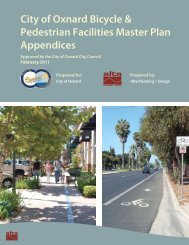Santa Clara River Trail Final Master Plan - Development Services ...
Santa Clara River Trail Final Master Plan - Development Services ...
Santa Clara River Trail Final Master Plan - Development Services ...
You also want an ePaper? Increase the reach of your titles
YUMPU automatically turns print PDFs into web optimized ePapers that Google loves.
Chapter 6: Design Guidelines, Maintenance Schedules and Best Practices<br />
prolong the life of the trail. Maintenance activities required for safe trail operations should always receive<br />
top priority. The following should be part of the maintenance checklist:<br />
Vegetation<br />
In general, visibility between plantings at trailside should be maintained so as to avoid creating the<br />
feeling of an enclosed space.<br />
This will also give trail users good, clear views of their surroundings, which enhances the aesthetic<br />
experience of trail users. Understory vegetation along the trail corridor shall not be allowed to grow<br />
higher than 36 inches. Tree species selection and placement should be made to minimize vegetative litter<br />
on the trail and root uplifting of pavement. Tree branching should be pruned up to a minimum of six feet.<br />
Surfacing<br />
Concrete is the recommended surface material for the <strong>Santa</strong> <strong>Clara</strong> <strong>River</strong> <strong>Trail</strong>. Concrete was chosen for<br />
its low-maintenance characteristics and its ability to weather annual flood events. When properly cared<br />
for, concrete will last indefinitely.<br />
The trail surface should be kept free of debris, especially broken glass and other sharp objects, loose<br />
gravel, leaves, and stray branches. <strong>Trail</strong> surfaces should be swept periodically.<br />
Pest and Vegetation Management<br />
Some basic measures should be taken to protect the trail investment. This includes a bi-annual shoulder<br />
plant trimming along both sides of the trail to prevent invasion of plants into the pavement area.<br />
Recommended time of year for shoulder plant trimming is in fall and in spring.<br />
All run-off will lead to the <strong>Santa</strong> <strong>Clara</strong> <strong>River</strong> and ultimately the Pacific Ocean. Use of chemical sprays for<br />
vegetation control should be avoided. Wherever possible, vegetation control should be accomplished by<br />
mechanical means or hand labor. Use of chemical sprays should be limited to use only on those plants<br />
that are harmful to the public such as poison oak. Effort should be made to eradicate invasive species<br />
found along <strong>Santa</strong> <strong>Clara</strong> <strong>River</strong>. Volunteer removal via hand labor is recommended.<br />
Vertical clearance along the trail should be periodically checked and any overhanging branches over the<br />
trail should be pruned to a minimum vertical clearance of 10 feet.<br />
Litter and Illegal Dumping<br />
Staff or volunteer efforts should remove litter along the trail. Litter receptacles should be placed at access<br />
points such as trailheads. Litter should be picked up once a week and after any special events held on the<br />
trail.<br />
Alternatively, the trail corridor could be signed “pack it in, pack it out.” This technique has been met<br />
with mixed results, but if maintenance funds are not available to meet trash removal needs, it is best to<br />
remove trash receptacles.<br />
Illegal dumping should be controlled by vehicle barriers, regulatory signage, and fines as much as<br />
possible. When it does occur, it must be removed as soon as possible in order to prevent further<br />
dumping. Neighborhood volunteers, friends groups, alternative community service crews, and inmate<br />
labor should be used in addition to maintenance staff.<br />
92 | Alta <strong>Plan</strong>ning + Design
















